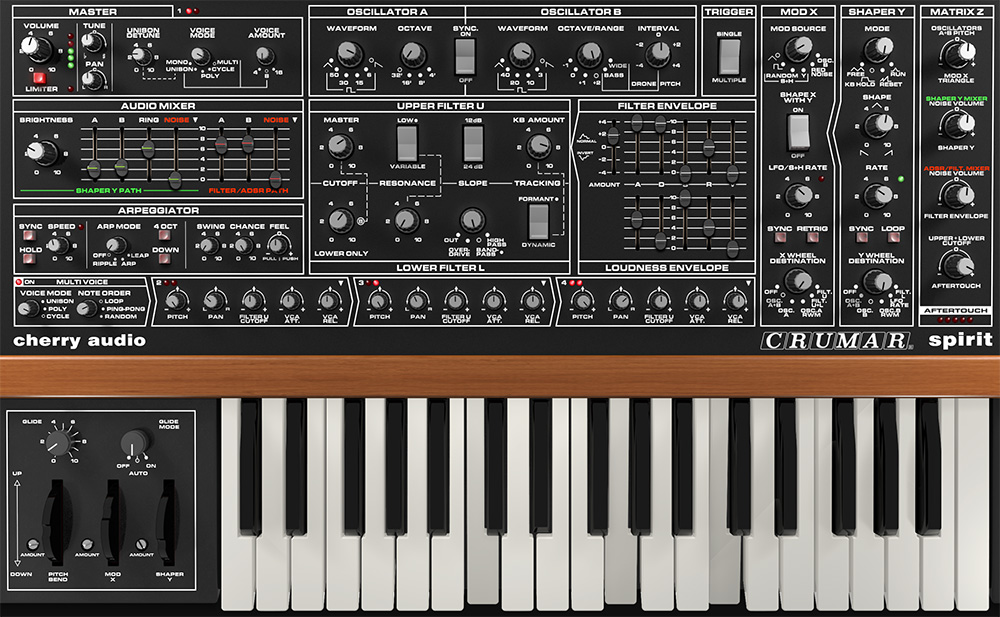
Overview
Crumar Spirit by Cherry Audio is not your average analog throwback. It’s a digital reimagining of one of the most adventurous synth architectures of the early 1980s. It's full of character, clever modulation paths, and more than a few surprises. At its core, Spirit is a dual-oscillator, dual-filter, dual-envelope monosynth. But that barely scratches the surface.
Let’s take a bird’s-eye tour of how this beast is wired under the hood and what that means for your sound.
The Spirit architecture is split into two main signal paths:
Filter/ADSR Path
This is your primary voice path. It mixes Oscillators A & B and the Noise Generator, then routes the signal through:Two voltage-controlled filters (Upper and Lower)
A VCA (Voltage-Controlled Amplifier)
Controlled by the Filter Envelope (for filter cutoff) and Loudness Envelope (for amplitude)
You’ll use this path for most of your traditional subtractive sounds — basses, leads, plucks, sweeps, and so on. Its output is routed to the Filter/ADSR Path in the Audio Mixer.
Shaper Y Path
This is the secret weapon. The same oscillator and noise sources (plus Ring Mod) can be routed here via the Audio Mixer, bypassing the filter section entirely. Instead, they pass through:A simple fixed BRIGHTNESS filter (6 dB/oct)
A dedicated VCA controlled by Shaper Y (a second modulation section with envelope and LFO modes)
The Shaper Y Path gives you clean, direct access to raw waveforms and modulated amplitude shaping. This makes it useful for percussive accents, bell tones via the ring modulator, bright pads, or layered textures. Its output is routed to the Shaper Y Path in the Audio Mixer.
Each signal path can operate independently or in tandem, allowing layering, parallel processing, or split-mod architecture, all within a single synth instance. In addition, each path has its own set of effects. More on this later.
Sound Sources
Two Analog-Style Oscillators
With selectable waveforms, octave ranges, detune, rectangle wave widths, and sync. Oscillator A handles the core pitch, while Oscillator B brings additional complexity.Noise Generator
A choice of red, pink, or white noise, ideal for percussion, wind, or noisy textures.Ring Modulation
A fixed connection between the triangle waves of Oscillators A and B. Creates metallic, bell-like, or atonal textures.
All sources can be blended and routed independently to either the Filter/ADSR Path or the Shaper Y Path using the mixer section.
Control and Modulation
Two Envelope Generators
Filter Envelope controls filter cutoff (always routed to Upper Filter; optionally to Lower Filter depending on mode).
Loudness Envelope controls amplitude in the Filter/ADSR Path.
Two Modulation Sections
MOD X is your primary LFO/clock source with selectable modulation destinations and rate control. It also drives the sample-and-hold generator and the arpeggiator.
SHAPER Y doubles as a second modulation generator, with envelope-like or free-running shapes, adjustable symmetry (SHAPE), and rate control. It also acts as a dedicated VCA controller in the Shaper Y Path.
Wheel Modulation Routing
Three modulation wheels (Pitch, Mod X, and Shaper Y) let you assign sources and control depth, making these a powerful way to add complex timbral movement and expressive real-time performance.
Arpeggiator
Off – No arpeggiation
Ripple – Plays held notes from lowest to highest, in a loop
Arp – Plays the same sequence across multiple octaves, up/down
Leap – Each note jumps up, then down an octave in rhythmic cycles
The arpeggiator is clocked by its own Speed control and can be synced to the master Tempo at the top of the instrument window. Its speed (and other parameters) can also be modulated by any Matrix Z modulation sources for surprisingly complex rhythmic patters.